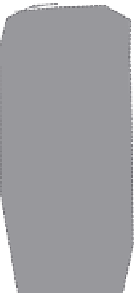Environmental Engineering Reference
In-Depth Information
(a)
(b)
Injection
pipe
Surface
q; injection rate
Sand
Cemented sand column
Horizontal
injection
Cemented
sand
Diameter; l
A
; sectional area
Coecient of
permeability; k
Hydraulic
gradient; i
Seepage
velocity; v
Downward
seepage flow
Drains
FIGURE 12.10
(a) Sand column formed in relatively deep sand layer. (b) Horizontal and downward low of the mixture of
bacteria and reactive solution in sand.
sand column obtained by injection of bacteria and reactive solution from a larger injection
mouth into a deeper soil layer—with the diameter of the sand column being a few folds
greater than that of the injection mouth.
To estimate the size of the cemented zone, one assumes that the injection rate of mixture
of bacteria and reactive solution is equal to the downward low rate at a horizontal section
with an area of A under a hydraulic gradient of one, as shown in Figure 12.10b. With these
assumptions, the size of the cemented sand column can be estimated using the following
relationship,
vA
e
===
/ 100
qvA iA
(12.13)
n
where
q
is the injection rate,
v
is apparent seepage velocity,
A
is the sectional low area,
k
is
the coeficient of permeability,
i
is the hydraulic gradient,
v
e
is the advection velocity, and
n
is the porosity.
12.6.2 Increased Strength due to Artificial Diagenesis
12.6.2.1 Unconined Compressive Strength
Unconined compression test results for a soil cemented by carbonate with a carbonate con-
tent of 0.84% reported by Fukue et al. (2011) showed that carbonate cementation endowed




















Search WWH ::

Custom Search